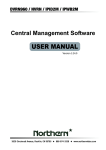Download Video Dispatch Server User`s Manual
Transcript
Video Dispatch Server User’s Manual Version 3.16 User’s Manual Table of Contents 1. Overview .......................................................................................................................2 1.1 System Requirement ...........................................................................................3 2. Software Installation.....................................................................................................4 3. Software Upgrade.........................................................................................................6 3.1 Automatic Software Upgrade ...............................................................................6 3.2 Manual Software Upgrade ...................................................................................7 4. Start Up VDS .................................................................................................................8 4.1 Starting Up ...........................................................................................................8 4.2 Login....................................................................................................................8 5. VDS Main Window ........................................................................................................9 5.1 VDS Icon in the System Tray ............................................................................. 11 6. Configure VDS ............................................................................................................12 6.1 Sites Edit ...........................................................................................................13 6.1.1 Groups Settings.....................................................................................13 6.1.2 Site Settings ..........................................................................................16 6.2 Login Setting......................................................................................................21 6.3 Users Edit ..........................................................................................................23 6.4 Client Setting .....................................................................................................25 6.5 Event .................................................................................................................26 6.6 File Path ............................................................................................................27 6.7 6.8 DynDNS.............................................................................................................29 Export or Import Settings ...................................................................................30 7. Operation of VDS........................................................................................................31 7.1 Talk Function......................................................................................................31 7.2 Instant Record Function.....................................................................................32 7.3 Schedule Record Function ................................................................................33 7.4 Lock Function ....................................................................................................38 Appendix A: Troubleshooting.........................................................................................39 1 User’s Manual 1. Overview Video Dispatch Server (VDS) is a dispatch server that bridges between DVRs / IP Cameras and CMS Clients. VDS serves as an agent that gathers data from its connected DVRs / IP Cameras and distributes to CMS Clients. In this way, loading of DVRs / IP Cameras will be much less stressful because CMS Clients will connect to VDS instead. Moreover, if VDS is scheduled to record videos, CMS Clients will directly playback from database of VDS, which reduces network occupancy of DVRs in a great deal. Features: z Connect Multiple Sites –Supports up to 32 IP devices z Event Function (LAN Only) – Receives event/alive signals from DVRs and transfers to connected CMS Clients z Device Search – Searches the LAN network for any available DVRs / IP Cameras z Schedule Record – Records live videos to the HDD according to schedule setup 2 User’s Manual z HDD Information – Display the available local HDD spaces for recording z Multi-Lingual Support – Supports 15 different languages z Multiple Administrative Management – Easy setup for multiple user accounts with various administrative privilege 1.1 System Requirement The following chart shows recommended computer system: Operating Systems Windows XP, Windows Vista, Windows 7 CPU Minimum: Intel® Core™ 2 Duo 2.4 GHz Recommended: Intel® Core™ i7-2600 8MB Cache 3.4 GHz RAM Memory Minimum: 1GB Recommended: 4GB HDD Minimum: 80GB Recommended: 1TB Ethernet Minimum: 100 BaseT Recommended: Gigabit LAN Tested Setup CPU: Intel® Core™ i7-2600 (8MB Cache, 3.4 GHz); RAM: DDR3 4GB; OS: Windows 7 Professional; Ethernet: Gigabit LAN; Mainboard Chip: Intel H6X NOTE: If the operating system is Windows Vista or Windows 7, some functions (such as Record, Auto Reboot, etc) will not work properly due to User Account Control (UAC). Follow steps below to solve this problem. Step 1. If a previous version of VDS is installed, export setting files of VDS before installing the new version VDS. Step 2. Due to UAC, user account in Windows Vista or Windows 7 cannot properly run applications that will write in “C:\Program Files\” folder. Therefore, VDS will be installed in “C:\” folder instead. Step 3. Once the new version VDS is installed, import the setting files back to VDS. 3 User’s Manual 2. Software Installation Follow the steps below to install VDS to the local computer. Step 1. There are 2 ways to start the installation. Option 1. Download the compressed file and extract it. Click on the VDSSetup.exe file to start the installation. Option 2. If VDS will be installed via a CD, the installation will startup automatically when the CD is inserted into the CD-Rom. The <VDS Setup Menu> window will be displayed. Choose <INSTALL VDS> to start installing VDS. Choose <VDS USER’S MANUAL> to open the user’s manual. Choose <EXIT> to exit the <VDS Setup Menu>. NOTE: 1. If an older version of the VDS had been installed in the local computer, a message box will be shown during the installation. Click <OK> to uninstall the previous version. 2. After clicking <OK>, an un-installation confirmation dialog will be displayed. Click <Uninstall> to uninstall the older version and continue with the next step. Step 2. Select the components that are going to be installed. It is strongly recommended to select the <Start Menu Shortcuts> to create shortcuts in the Start Menu and on the Desktop. Otherwise whenever the program is to be opened, it will have to be found under the path: “\VDS\EXE\VDS.exe”. Click <Next> to go to next step. 4 User’s Manual The components of the VDS Installation Setup are: a. Microsoft VC 2008 SP1 Redistributable Package: This is an upgrade package required for correctly running VDS. b. Video Dispatch Server 3.16.0 (Required): The VDS main program must be installed. c. Start Menu Shortcuts: Check the box to create shortcuts in the Start Menu and on the Desktop. d. Default Setting (Old setting will be deleted!): Check the box to load default setting, or uncheck it to load the old setting of previous installed VDS. Step 3. The VDS main program will be the first program to be installed. Choose a folder to install the VDS or it will be installed to a default destination folder “\VDS\”. Click <Install> to start the Installation; or click <Back> to go back to the previous step. Step 4. When the Software Installation is completed, click <Close> to exit. 5 User’s Manual 3. Software Upgrade VDS software can be upgraded automatically or manually. Refer to the following sections for details. 3.1 Automatic Software Upgrade To enable automatic software upgrade, right click on VDS icon in the system tray and check “Auto Upgrade”. If automatic software upgrade is enabled, VDS will connect to the FTP Server and check for upgrade once a month. If no upgrade is available, VDS will continue normal process. If upgrade is detected, please follow the steps below to proceed. Step 1. A message box will pop up to inform that there is upgrade available. Click <OK> to download the upgrade software and continue to the next step. Otherwise, click <Cancel> to abort and continue to normal VDS process. Step 2. Choose a destination folder to save the file. Then a window will pop up and show the downloading status. Click <Abort> to terminate the download and VDS will be started as usual. Step 3. When the download is completed, the installation of the new version of VDS can be started following the same procedures described in section Software Installation. NOTE: If the upgrade file is not completely downloaded or is broken, an error message will be displayed. NOTE: A release note will also be downloaded together with the setup file. A message window will pop up to show the file path where the release note is saved. 6 User’s Manual 3.2 Manual Software Upgrade To manually upgrade software, click on the <Setting> button and click on <Software Upgrade> at the bottom. Then follow the steps in the previous section to complete the download and installation. 7 User’s Manual 4. Start Up VDS There are 3 ways to start VDS. Note that method A and B are only available if the “Start Menu Shortcuts” component is installed. Please see section Software Installation for more information. Method A. Click Start menu and select Programs. Then find “VDS” from the listed programs. Method B. Double click on the shortcut icon on the desktop. Method C. Go to “\VDS\EXE\” and double click on VDS icon. 4.1 Starting Up If VDS is started for the first time, select a desired language for the interface. The available languages are listed in the scroll box. Click <OK> to confirm the selection. NOTE: If the system memory or CPU frequency is less than the requirement, the error message will be displayed. 4.2 Login The default username & password are: “admin” and “1234”. Enter the default username and password, then check <Save user name and password> to save time from entering username and password every time VDS starts. Click <OK> to login. The username and password accounts can be added or removed under the <Users Edit> tab in <Setting> configuration window. Refer to the Users Edit section for more information. NOTE: If wrong username or password is entered for 3 times, an error message will be displayed, and VDS will be closed automatically after <OK> is clicked. Restart VDS to enter the correct username and password. 8 User’s Manual 5. VDS Main Window The main window of VDS is as the below. 1 Schedule Record 2 Connect All Sites 3 Setting 4 Lock 5 CMS Client Login Info 6 Site Tree 7 System Log Data 8 HDD Info 9 User’s Manual The usage and function of each button will be briefly described as follows. Schedule Record Click on the <Schedule Record> button to schedule the recording time frame for the connected sites. Connect All Sites Click on the <Connect All> button to re-establish connection to all sites in the site tree. Setting Click on the <Setting> button to setup the configuration. Refer to section Configure VDS for detailed information. Lock Click on the <Lock> button to lock VDS to protect the works on VDS when users need to be away from the computer for a while. This function is the same as the computer’s screensaver. See section Lock Function for more detailed information. CMS Client Login Info A list of login CMS Clients will be shown in this area. The information includes the login users’ account names, IP addresses, and whether if the talk function is enabled. The listed CMS Clients will not exceed maximum number of connection setup in <Client Setting>. Refer to section Client Setting for more details. NOTE: If CMS Clients have been idled for more than 4 minutes, VDS will automatically kick off the connections. 10 User’s Manual Site Tree The site tree displays the site(s) of current start group. Right click on the “site” and select <ReConnect> to re-establish connection to the site. The <DisConnect> option allows users to only disconnect a certain site. The <Record> option gives users freedom to instantly record videos of the selected site. Details of this function will be explained later in section Instant Record Function. By right clicking on the group icon, the options shown as on the right allows users to expand or hide the site tree. System Log Data The operational and system logs of VDS and CMS Clients will be listed in this area. HDD Info Move the cursor to the display bar of a HDD, then a hint message with a brief information of the selected HDD will be shown. 5.1 VDS Icon in the System Tray When VDS has been started up, VDS icon will always be shown in the system tray. Right click on VDS icon and the menu items will be shown as on the right. If <Minimize To Tray> is checked, VDS window will shrink to VDS icon in the system tray when it is minimized. The taskbar button will also disappear. To restore VDS window, double click on VDS icon and the taskbar button will also appear at the same time. Alternatively, right click on VDS icon and select <Open Video Dispatch Server > and VDS window will be restored. Select <Help> will pop up the PDF file of the User’s Manual. 11 User’s Manual 6. Configure VDS Click on the <Setting> button and a window as below figure will be displayed. The configuration items of VDS and their brief description are listed as below: Sites Edit Setup and management of connection groups and sites. Login Setting Setup login options of VDS. Users Edit Setup and management of login user accounts. Client Setting Setup and management of CMS Clients. Event Setup event notifications from DVR sites. File Path Setup directory of recorded videos. DynDNS Setup a static domain name for dynamic IP The following subsections will guide users to setup VDS step by step. 12 User’s Manual 6.1 Sites Edit VDS supports up to 10 groups, with at most 32 IP devices can be added to each group. If more than 32 IP devises are added, error message will be displayed. This section will guide users to setup and manage connection groups and sites. 6.1.1 Groups Settings Add Groups Right click on <Groups List>, and select <Add a group> to add a group. The bottom two menu items allow users to expand or hide all groups. 13 User’s Manual Rename / Remove Groups Right click on a preferred group and select <Rename> to change name of the group. Also, right click and select <Remove> can remove the selected group. Set Start Group “Start Group” is the group that will be connected after started up VDS. Right click on a preferred group and select <Set as start group> from the pull-down menu. The start group icon will be different, as shown below. 14 User’s Manual Expand / Hide Groups To expand or hide a group, right click on the group and select <Expand> or <Hide>. 15 User’s Manual 6.1.2 Site Settings This section is the instruction of the management of sites, including addition, removal and configuration of sites. Add Sites Right click on a group, and select <Add a site> to add a new site to the group. Remove / Rename Sites Right click and select <Remove> / <Rename> to remove / rename the site. 16 User’s Manual Input IP Address and Port – Manually or Device Search Users can manually input IP address and port of a site, or via Device Search. VDS can search for existence of DVRs and IP Cameras in the PC’s LAN network. The ports used for device search are 6666 and 6667. Please make sure that these two ports are not in-use nor blocked by firewall or virus scan software. Follow steps below to search for DVR(s) or IP Camera(s): Step 1. Click the <Device Search> button (on the bottom right) to open the Search window. Step 2. The list will show DVR(s) and IP Camera(s) found in the LAN network. Select from the list and Double Click on any device to add it to a new site. 17 User’s Manual NOTE: The Device Search function can only be used to search for devices within the same LAN. For example, if the PC’s IP address is 192.168.1.5, and a connected DVR has an IP address of 192.168.1.7, VDS will be able to find the DVR. However, if there is another DVR connected to another LAN network such as 192.168.3.6, VDS (whose IP is 192.168.1.5) will not be able to find the DVR in another LAN network. DDNS Address The IP address of a DVR can also be entered with a DDNS address. Check the box <(D)DNS> as circled below, and type in the DDNS address. An example of the DDNS address looks like: *******.ddns.iview-ddns.com 18 User’s Manual Setup DVR Sites When adding a DVR site, input the DVR’s IP address and port manually or via Device Search, as described above. Then enter username and password for login to the DVR. Select <DVR> and click <OK> to complete the setting. NOTE: If the entered Username and Password is a user account instead of an administrator account, the same DVR account restriction will be applied. 19 User’s Manual Setup IP Camera Sites When adding an IP Camera site, input the IP Camera’s IP address and port manually or via Device Search, as described above. Then enter the IP Camera’s username and password. Select <IP Camera> and choose the <Stream Type>. Click <OK> to complete the setting. 20 User’s Manual 6.2 Login Setting Users can edit options regarding login settings in this section. Administrator username and password is required to edit login setting. Verify Account As shown in the above picture, the box marked “1” is where users can enter a set of username and password to be used for auto login. The <Verify> button can help users to check if the username and password are correct. A message box will be displayed to inform the result of verification. 21 User’s Manual Automatic Actions The box marked “2” contains the options regarding automatic actions. Clicking the first option “Start Video Dispatch Server when Windows starts up.” to request the computer to open VDS in the mean time when the system startup. Note that the other two options “Auto Login” and “Auto connect device when login” will be checked at the same time. Nonetheless, it is still users’ choice to determine the favorite setting. A message window will be shown when VDS is auto opening after the system started up. Click “Cancel” can terminate opening VDS. Click the second option “Auto Login” to automatically login when VDS starts. Remember to enter and verify username and password in box 1. Click the third option “Auto connect device when login” to automatically connect to the sites in the start group when VDS starts. Detection of internet connection will be performed before hand and a message window will be displayed. Click <Stop> to terminate the detection and auto connection will not be initiated. 22 User’s Manual 6.3 Users Edit <Users Edit> is for the management of login accounts in VDS. The default username and password are “admin” and “1234”. NOTE: Only accounts under the <Admin> group have the privilege to change the settings in <Users Edit>. Add Accounts Right click on “Admin” or “User” and select <Add User> to add a new account. 23 User’s Manual Setup Password and User Name After the new account is added, “Password” MUST be set for this account before users can go to the next step. When “Password” is set, “User Name” can be changed if users wish to. Note that “User Name” is case sensitive. Add Accounts Right Click on an account and select <Remove User> to remove the account. NOTE: The account currently used to login cannot be deleted. 24 User’s Manual 6.4 Client Setting In <Client Setting> tab, users can specify white and black lists of CMS Clients’ IP addresses, connect port, and maximum connections of CMS Clients. In addition, users can choose to save system log data in selected folder. On the left hand side, input IP addresses of CMS Clients and click on <Add to white list> or <Add to black list> to add the specific IP addresses to the white or black list. The added item can be found in the list below the buttons. If users wish to delete any item, click on the item first and click on <Delete> to do so. In addition, click on <Allow All> to allow free access. Alternatively, click on <Block All> to block all access. Users can specify “Connect Port” and maximum number of connections on the right hand side. NOTE: The maximum number of connections cannot exceed “5”. Check the box in front of “Save Log” and select a folder to save the system log data in a text file. 25 User’s Manual 6.5 Event The <Event> tab enables the connected DVR(s) to send alert signals to VDS, and VDS will transfer the alert signals to CMS Clients. The <Alert Notification> options are <OFF>, <Event>, <Alive>, and <Both>. The only difference is that transfer of alert signals is from VDS to CMS Clients here. <OFF>: The Alert Notification is turned off. <Event>: When an alarm is triggered, VDS will send an alert signal to connected CMS Clients. <Alive>: VDS will send an alive signal to connected CMS Clients every N seconds just to show that the connection between the DVR and VDS is in effect. The time interval N can be adjusted in <Alive Interval>. <Both>: Select this and VDS will send both Event and Alive alert signals to connected CMS Clients. Setup <Alert Interval> from 10 seconds to 120 seconds. <Event Recording Duration> is for users to define recording duration of event videos, when event recording time is defined record schedule. 26 User’s Manual 6.6 File Path In <File Path> tab, users can specify destination folder(s) for recorded videos. The preset folder is \VDS\Record\. Then users can choose whether to enable circular recording. Select Destination Folders The number of selectable folders equals to the number of HDDs the PC connects to, excluding HDDs with capacity less than 2GB. Check the box in front of “Enable” and click on <Browse> to select more destination folders. Each folder should be from different HDD or an error message will be displayed. Note that if a HDD with less than 2GB capacity is selected, an error message will also be shown. Click on <Clear All> will delete all folders except the first preset folder. In each folder, subfolders will automatically be created with folder name “RecordFolder********”, which ******** represents an 8-digit serial number. Each subfolder can store up to 500 videos. Once a subfolder is full, a new subfolder with a subsequent number will be created and new files will be stored to the new subfolder. 27 User’s Manual Circular Function The <Circular> function is used to adjust the HDD space usage of VDS. Select <ON> to enable circular function and choose type to be <By Size> or <By Percentage>. Then specify the value of threshold. Note that the threshold value cannot be less than 2GB by size or 2% by percentage. For example, when the threshold is set to 2GB, and there are 20GB free disk space remaining in the HDD, VDS can only access the HDD no more than 18GB. When the free disk size is smaller than threshold: 1. If the circulation of files is performed at first time, VDS will start to overwrite the earliest recoded data. Next time when VDS starts up, the circulation of files will continue from where it was up to. 2. If the destination folders are reset, new folders will be created to store new files. The old files will be deleted and rewritten with new files. 28 User’s Manual 6.7 DynDNS For users who are using dynamic IP addresses, DynDNS can help to link the dynamic IP addresses to static domain names. This way the IP addresses setting will not need to be changed all the time at the CMS Client sides. Before setup DynDNS, users have to register their own free accounts at the website http://www.dyndns.com/. Users will receive a pre-determined hostname from the website after successfully registered. Input the username, password, and hostname in DynDNS setup page. Synchronize IP There are three options for users to synchronize their dynamic IP addresses to their assigned domain names: 1. Synchronize IP automatically when Video Dispatch Server starts up 2. Synchronize IP in a 30 minutes interval 3. Manual synchronize IP Users can select preferred options according to their application. 29 User’s Manual 6.8 Export or Import Settings The export/import function provides users the option to backup the settings as needed. To export the configuration, click on <Export> button and select a destination folder to save the *.zip file. To import a configuration, click on <Import> button and find the *.zip file that was previously saved. NOTE: An error message will pop up if the imported configuration has more than 32 IP devices. NOTE: After a configuration is imported and <OK> button is clicked, the configuration will be loaded immediately and VDS will reconnect to the sites in the start group. 30 User’s Manual 7. Operation of VDS The brief descriptions of VDS main window layout and buttons are explained in section VDS Main Window. This section will introduce operational functions of VDS. 7.1 Talk Function The talk function enables CMS Client sides to communicate with VDS side. In CMS Client Login Info area, the “Talk” column allows users to enable or disable the talk function for each CMS Client. Check the box under the “Talk” column to enable the talk function of selected CMS Client. Then from the CMS Client side, the talk function can be initiated. Refer to the CMS User’s Manual for more information about how to initiate the talk function between CMS Client sides and VDS side. 31 User’s Manual 7.2 Instant Record Function VDS also allows instant record function. Users can record live videos of DVRs and IP Cameras to the local computer instantly. Right click on a Site and select <Record> Æ <Start Instant Recording> to start recording. When users want to stop recording, right click and select <Record> Æ <Stop Instant Recording>. If time difference between VDS and the recording site is more than 1 day, a warning message will be displayed. NOTE: If the connection to the recording site is disturbed and then reconnected, the recording will be terminated without resumption. 32 User’s Manual 7.3 Schedule Record Function Users can schedule specific time to record the connected devices’ videos to the local computer. Schedule Record window will be displayed after clicked on the <Record> button. The current setting site will be shown on the top of the Schedule Record window, as circled in the picture below. Alternatively, users can click on the <Select All> or <Clear All> buttons to setup all sites to always record or always not record at once. Select Video Types The scroll-down menu circled below shows the recording video types. <OFF> Select this to switch off the schedule record function. <NORMAL AND EVENT> Schedule to record both the normal and event videos within the selected time frame. 33 User’s Manual <EVENT ONLY> Schedule to record only the event videos within the selected time frame. Select / Clear Cells The scroll-down menu circled below shows the selecting options. <SELECT CELL> Choose this to select any cell from the table. <CLEAR CELL> Choose this to clear any cell from the table. <SELECT ALL CELL> Choose this to select all cells from the table. <CLEAR ALL CELL> Choose this to clear all cells from the table. Follow steps below for an example of setting schedule record for VDS. 34 User’s Manual Schedule Recording Times Step 1. Select a site or a channel from the box on the right by a single click. When a site is selected, the same setting of schedule record will be applied to all channels. Click on a channel to set unique schedule record for the particular channel. In this example, schedule of a site will be set. Select a site in box 1, and set the recording option to <NORMAL AND EVENT> in box 2. Step 2. Assuming that the site will be scheduled to start recording video from 2:00 to 4:30 on Tuesday and Wednesday. Since the duration of each cell is 30 minutes, click on the cell under 02 for Tuesday and drag to the cell under 04 for Wednesday; and the color of the cells will be changed to purple indicating that both normal and event videos are going to be recorded during the selected times. Step 3. After the time frames are selected, click <OK> to save and exit the Schedule Record window. 35 User’s Manual Cancel Scheduled Recording Times If the user want to cancel a time frame from selected schedule, for instance, 3:00~3:30, set the selecting option to <CLEAR CELL> in box 1. Click and drag the cells under 03 from Tuesday to Wednesday. The cells will be blank which indicates that VDS is not going to record anything. Click on <OK> to save and exit the Schedule Record window. Select/Clear All Cell If users want to set the schedule to record at all times, click on the circled blank cell located on top left corner of the table or set the selecting option to <SELECT ALL CELL>. If users want to reset the schedule of the site, set the selecting option to <CLEAR ALL CELL>. Click on <OK> to save and exit Schedule Record window. 36 User’s Manual Select/Clear Cell by Date/Time Another way to select or clear time frame is by clicking on the Day or Time tabs. For example, when users click on <Tue> tab, the color of all Tuesday cells will be changed and the site is scheduled to record normal and event videos every Tuesday. When users click on 5:00~5:30 tab, color of all 5:00~5:30 from Monday to Sunday will be changed. Click on <OK> to save and exit Schedule Record window. Special Schedule of a Specific Date If users wish to setup a special schedule for a specific date, simply select a date from the pull-down menu of <Holiday Setup> and click on <Add> button. At the bottom of the <Schedule Record> window, users can find a new row of the added date as shown below. Setup the schedule for that date, and the schedule record will only run once for that special day. 37 User’s Manual 7.4 Lock Function The Lock function allows users to protect VDS from unauthorized use when there is need to be away from the computer for a while. When VDS is locked, all functions (including setting and operation) are not available. Click on the <Lock> button and a confirmation message will be displayed. Click “Yes” to confirm. Once users confirmed to lock VDS, the button will be changed to <Unlock> and all other buttons will be grayed out. When users click on the <Unlock> button, the unlock window will be displayed for users to enter username and password to unlock. To unlock, there are two scenarios as listed below: Login Account Accounts Able to Unlock Note 1 User Level - Login User - Any Administrator The access authority will still be User’s limit. 2 Admin Level - Login Administrator If password is changed, use new password to unlock. NOTE: If VDS is forced to be closed while it’s locked, VDS system will still be locked when it is started up again. NOTE: If the password of the current login account is changed, use the new password to unlock. 38 User’s Manual Appendix A: Troubleshooting The followings are some common situations when the user is having difficulty with VDS. 1. VDS does not work properly. How can it be recovered or where can I ask for help? Please try the following ways to recover it first. A. Please check if the computer meets the system requirement. B. If VDS automatically closes when it’s starting up or connecting to sites, please send the files stored in \VDS\VDS_Setting\ under improper operation condition. Afterwards, re-install VDS and check to install Default Setting during installation. Remember not to import old setting files. This will tell whether if the old setting data are corrupted. C. If VDS cannot successfully connect to sites, check the followings. z Confirm IP, port, username, and password of the sites. Users can connect to the sites via IE browser to verify the sites exist and are connectable. z Close firewall and virus scan software and try to connect again. If the problem is due to the blocking of the firewall or virus scan software, please change their settings. z If the connection still failed, please send the IP address to our engineer. NOTE: When users need to ask for the engineer’s help, please send a copy of the files stored in \VDS\Log\ as well. 39 User’s Manual 2. VDS takes up too many HDD space. We have found that the preset of the virus scan software “NOD32” will automatically create a temporary file under windows system temporary folder when VDS connects to sites. This temporary file will automatically increase the size which causes the HDD became lack of space. Please go to the control center of the NOD32 and disable IMON. Then the problem should be resolved. The following pictures are examples. 40


















































